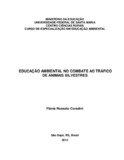| dc.contributor.advisor | Steffani, Evandro | |
| dc.creator | Coradini, Flávia Rossato | |
| dc.date.accessioned | 2015-05-13T14:40:02Z | |
| dc.date.available | 2015-05-13T14:40:02Z | |
| dc.date.issued | 2013-12-13 | |
| dc.date.submitted | 2013 | |
| dc.identifier.uri | http://repositorio.ufsm.br/handle/1/806 | |
| dc.description | Monografia (especialização) - Universidade Federal de Santa Maria, Centro de Ciências Rurais, Curso de Especialização em Educação Ambiental, EaD, RS, 2013. | por |
| dc.description.abstract | The trafficking of wild animals has been a significant factor in the reduction of biodiversity in Brazil , contributing to the removal of millions of wild specimens from nature . Biodiversity ensures the balance of ecosystems worldwide . The damages caused to biodiversity affect not only the species that inhabit a specific place , but all the others species as well, and also the environment itself , once it undermines the thin web of relationships between them and the environment where they live . However , the way it has been explored causes destruction to the ecosystems , affecting the lives and promotes the extinction of numerous species . This work aims to explain to the population from Cacapava do Sul and the region around , about the great problem of wildlife trafficking , informing how importante is to keep the animals in nature . The study was conducted at Dinarte Ribeiro School, with students in the 6th grade from the elementary school and the students of the 1st year from high school. The other school where this project has been conducted was Professora Eliana Bassi de Melo School , with students of 6th and 7th grade from elementary school . The work consisted of a lecture and subsequently a questionnaire was applied in order to evaluate the level of awareness caused by the lecture. Through the students' answers it is clear that they understand what is a wild animal, that they should not buy or sell these animals . They understand the difference between a wild animal and a domestic animal , and beyond that, they even reported some consequences that trafficking can cause to nature. | eng |
| dc.language | por | por |
| dc.publisher | Universidade Federal de Santa Maria | por |
| dc.rights | Acesso Aberto | por |
| dc.subject | Tráfico | por |
| dc.subject | Educação | por |
| dc.subject | Animais | por |
| dc.title | Educação ambiental no combate ao tráfico de animais silvestres | por |
| dc.title.alternative | Environmental education in the fight against trafficking of wild animals | eng |
| dc.type | Trabalho de Conclusão de Curso de Especialização | por |
| dc.degree.local | Polo de São Sepé, RS, Brasil | por |
| dc.degree.specialization | Educação Ambiental, EaD | por |
| dc.description.resumo | O tráfico de animais silvestres vem sendo um significativo fator de redução da biodiversidade no Brasil, contribuindo com a retirada de milhões de espécimes silvestres da natureza. A biodiversidade garante o equilíbrio dos ecossistemas do mundo todo. Os danos causados à biodiversidade não afetam somente as espécies que habitam determinado local, mas, todas as outras e também o próprio ambiente, uma vez que prejudica a fina rede de relações entre elas e o meio em que vivem. No entanto, a forma como ela vem sendo explorada provoca a destruição dos ecossistemas, afeta a vida e promove a extinção de inúmeras espécies. Este trabalho tem por objetivo esclarecer a população de Caçapava do Sul e região sobre o problema do tráfico de animais silvestres, informando a importância da conservação dos animais na natureza. O trabalho foi realizado nas Escolas Dinarte Ribeiro, com os alunos da 6ª série do ensino fundamental e com os alunos do 1º ano do ensino médio e na Escola Professora Eliana Bassi de Melo, com os alunos da 6ª e 7º série do ensino fundamental. O trabalho constituiu-se de uma palestra e posteriormente a aplicação de um questionário com o objetivo de avaliar o nível de sensibilização provocado pela palestra. Analisando as respostas dos alunos fica claro que os mesmos entenderam o que é um animal silvestre, que não devemos comprar ou vender esses animais, eles conseguiram diferenciar objetivamente a diferença de um animal silvestre de um animal doméstico, e, além disso, relataram algumas consequências que o tráfico pode causar a natureza. | por |
| dc.publisher.unidade | Centro de Ciências Rurais | por |


